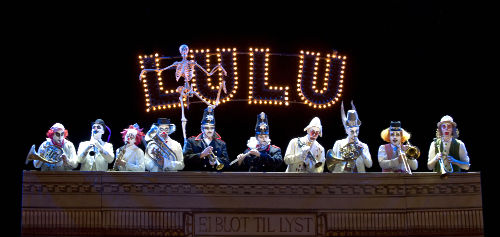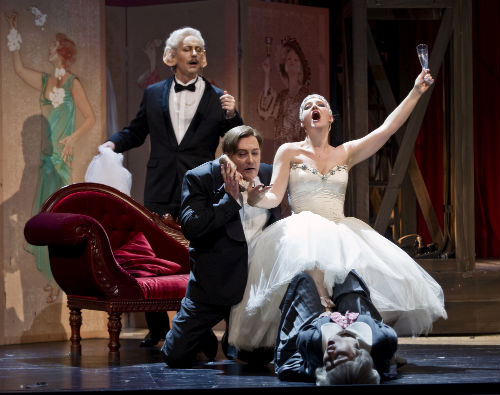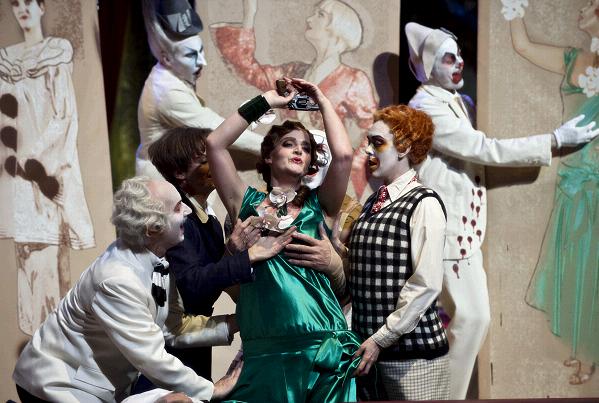It’s fortunate that Lulu at Den Norske Opera was the last stop on the “Regietournee,” because honestly anything after that would have amounted to an anticlimax. If there is a more brilliant director working in opera today than Stefan Herheim, well, maybe I shouldn’t see any of his work, because it might be too much for the human brain to absorb.
Herheim, though: what a dazzling, intellectually probing approach to an opera that’s (still) more often than not done “straight,” following the Berg/Wedekind stage directions. And, even more impressive, how different a take this is, and yet how valid!

So, enough babbling. Herheim’s vision of the work is layered, as indicated by the main setting for the work (Heike Scheele, designer): a circular semi-transparent wall (perhaps suggested by the new building housing the Royal Danish Opera, where the production premiered) that opens to reveal a smaller “theater,” this one a facsimile of the proscenium of the old Royal Danish Theater in fussy 19th century style, complete with grand drape and motto “Ei blot til lyst,” i.e., “Not only for pleasure.” Not immediately apparent is a smaller model of the same structure, toy theater size, on a a wheeled cart stage left.
To the right of the stage, remaining in place throughout, is a theatrical dressing table that will get a lot of use a little later in the action.
Now, the framing structure of Lulu is already defined as a circus sideshow, with each of the characters an animal type, with the heroine famously the snake. Herheim takes this concept a good deal further by introducing a gaggle of clowns who are onstage through most of the opera, changing scenery, lurking and observing from an upper gallery, and from time to time intruding on the action. They are also a circus band backing up the drum and cymbal player, and, well, we’ll eventually find out that they are a lot more than background extras.

Lulu is introduced not as the Serpent but as Eve, her three-dimensional form in a body suit protruding from a flat poster of the apple tree. That poster (with a Lulu-shaped hole in the middle) becomes the portrait the Painter is working on in the first scene. Notable in that scene was the attitude Herheim gives Lulu: not bored, not kittenish, but downright slutty, deliberately trying to cause trouble first with Alwa and then with the Painter.
The first “tangent” from the expected action of the piece comes at the end of the scene, after the death of Lulu’s husband the Doctor. She returns asking the Painter to hook up her dress, but, surrealistically, she is in a wedding gown complete with veil. Once she’s dressed, she wrests the wedding ring from the Doctor’s dead hand and puts it on her own.
Each of the interludes is staged, following more or less the pattern of what happens in the first: the clowns descend from their gallery and collect the body of the Doctor, carrying him over stage right to the dressing table. They change his costume to an all-white outfit (matching their own) and then one of the clowns does makeup and hair on the “corpse.” Once the transformation is complete, the Doctor seems to wake up, surprised, and gazes at himself in the mirror before joining the band of clowns and retiring above the stage to observe the next scene.
We might as well discuss the meaning of this pantomime here, and thus understand that spoilers follow. Though it’s not immediately apparent, as the dressing and reanimation of the dead characters continues, we begin to see that the clowns following Lulu around are ghosts of her former lovers who presumably all died because of her. What’s more, gradually we notice that Lulu is most of the time aware of their presence (though nobody else seems to see these spectres) and so the ghosts also serve as a symbols of Lulu’s memory of her experiences with men: a whole string of grotesques she can hardly tell apart.
This scene also introduces a note of grotesque brutality that shifts the tone of the opera from pathos to something approaching black comedy. As Dr. Schön torments the Painter, the set revolves, bringing the translucent panels to the front of the stage. Then the Painter goes into the “room” inside the panel unit to commit suicide, with blood spurting and dripping down the inside of the glass luridly. Lulu doffs her dressing gown to announce “Sie heiraten mich ja doch!” and Schön pulls her into another side panel unit to take her from behind as the interlude begins.

The arriving police are the clowns, who goggle a moment at the sex scene and then fetch the bloodied Painter and drag him away from watching the sex scene between Lulu and Schön, leading him to the dressing table for “resurrection.” This is a striking costume touch, because the cuckolded Painter is styled as Pagliaccio, with a red ruffle on his all-white blouse indicating the circumstances of his death. This coding is made clear through the costuming of the attending clown, who sports a giant noose dangling from his neck.
As this action finishes over at the dressing table, the turntable completes it revolution, revealing the theater dressing room. Now we begin to notice another Herheim touch, which is that the set for each scene is made up of the previous set, rearranged, and with an extra piece or two added. Thus as the first half of the opera continues, the stage grows increasingly cluttered, but there is never any real sense of newness about a freshly-revealed scene: it’s always going to be the same old junk just seen in a different configuration.
The “old” elements here include the theater proscenium, now turned around so it is seen from “backstage.” A new piece, a neon sign reading “LULU” is visible also in reverse. The screen is made up of flats depicting Lulu in various attitudes and outfits, which apparently are the many paintings the Painter sold during his marriage to her. (By inference, we realize that the paintings were all bought up by an admirer of Lulu, probably Dr. Schön.)

Lulu is still wearing her “wedding dress,” accessorized now into a ballet costume. The Prince is a grotesque with oversized ears, but that doesn’t stop Lulu from fondling him behind the screen while dressing for the stage. The Wardrobe Woman here is a frustrated lesbian hopelessly devoted to and jealous of Lulu, and Lulu seems to delight in teasing her, even roughly grinding her pointe shoe into the woman’s crotch. The scene of Lulu’s dance, which usually is played offstage, is presented here as viewed from backstage, through the back of the false proscenium, with a haze of theater lighting, and then, off in the dim distance, a center theater box where Schön sits with his fiancée.
Now Herheim introduces an witty note of deconstruction. After Alwa muses “Über die liesse sich freilich eine interessante Oper schreiben,” he proceeds to do just that: crossing over to the grand piano, he starts scribbling on staff paper, at first apparently transcribing what other characters are singing, and then, eventually, overtaking them. Then he writes out a phrase and hands the page to another character, who sings the “text” Alwa has just invented. (This is played for a delicious gag when Schön asks Lulu about the Prince. For a moment she’s not sure what to answer, until Alwa scribbles a line for her to read. “Er nimmt mich mit nach Afrika,” she replies in a phrase hopping up to high C; then she tosses the sheet away angrily, as if to say, “Nobody can sing that!”)
The ugly scene between Schön and Lulu is played as publicly as can be imagined, with even the fiancée dragged into the dressing room by the clowns so she can overhear the sordid details. So overcome with jealousy are the Wardrobe Woman and the Prince they they simultaneously commit suicide (she strangling with Lulu’s scarf, he plunging Alwa’s quill pen into his ear), which hilariously has the effect of canceling each other out: nobody seems to notice, and Schön even pulls the quill from the Prince’s bleeding ear to transcribe the breakup letter, yes, in blood. At this point, Alwa’s imagination perhaps gets the best of him, because (as he devises the scene), the fiancée clutches her heart and keels over, giving Lulu the chance to upstage Schön’s curtain line “Jetzt – kommt – die Hinrichtung…” by stealing the girl’s engagement ring!
I should mention here that the clown posse really take an active part in the show, in particular slowly closing in on Lulu’s next victim, even silently clapping their hands as if delighting in the suspense. During the second act, which is a reconfiguration of the proscenium, Lulu’s portraits and various other pieces into Dr. Schön’s drawing room, the clowns take positions at the top of column forming the corners of the space.

This is a very busy act and I think I would have to see it five more times to catch every detail. One new principle is that, since they died in a previous scene, the doubled roles (Prince and Manservant, Wardrobe Woman and High School Boy) return in this act as “ghosts,” though they’re not the invisible types who hover around the perimeter. A couple of details that stand out:
- Schön spies on Lulu from the clown’s gallery above the room, with the clowns eagerly pointing out her transgressions.
- The clown all assemble around Lulu in time for her Lied and even give her a burst of applause at the end of the aria.
- The piano tone clusters are mimed by Alwa at a grand piano as if (ineptly) composing the score of the scene in progress.
The interlude between scenes 1 and 2 is not done with the prescribed film but rather as a mimed sequence using the Lulu painting as a sort of cage to confine her. At the midpoint of the famous musical palindrome, a clown tosses the white Lulu dress over the screen (rising figure) and then the garment is thrown back at him (mirroring falling figure)
And then the screen structure starts so smoke and shudder until it finally exploded, revealing Geschwitz reclining on the sofa, and we are into scene 2. Here Herheim plays with the idea of illness as disguise, having Schigolch carry in a skeleton in Lulu’s ballet dress. The real Lulu is very obviously hiding under his cloak, pulling a string to move the skeleton’s mouth like a ventriloquist’s act. Even after the Acrobat leaves in disgust, the skeleton remains seated proudly at the grand piano, and Alwa goes so far as to sing his “Dithyrambus” to this obviously false image of Lulu.
Meanwhile he has continued scribbling music, finally handing a sheet of staff paper to Lulu, which she reads like a singer routining the rhythm of a tricky phrase: “Ist das noch der Diwan auf dem sich Dein Vater verblutet hat?” If anything, this comic subversion of the second act curtain line is stronger than the original “creepy” reading: Lulu’s “enigmatic” personality, Herheim seems to imply, is purely a construct, a creation of Wedekind and Berg. All she does is read the lines given to her.

The Pirandellian trope that the opera (and therefore, our understanding of the story of Lulu) is being created before our eyes by a less than completely reliable narrator is precisely the concept that informed the Wooster Group’s amazing production of Vieux Carré last winter here in New York. It’s to Herheim’s credit that in Lulu this notion is worked out so elaborately and so well. The third act begins with a short silent scene of Alwa and “real” conductor John Fiore — identically dressed in white tie — doing a sort of mirror game, walking out simultaneously (Alwa on stage, Fiore in the pit), acknowledging the applause, and then playing a bit of Alphonse and Gaston over which of the twins should give the downbeat.
Fortunately, Fiore wins, because it’s immediately obvious that Alwa (hilariously played by Gary Lehman: who knew?) is a really awful conductor, subdividing the first downbeat and getting worse from there. He totally confuses the onstage clown band and his “soloists,” the characters of the Paris scene, assembled in ranks and desperately clutching their sheet music.
It should be noted that as the opera works “downward” from the high point of the musical palindrome, Herheim’s staging gradually loses the set pieces that accumulated during the first half. But the visual interest stays high because of the new characters introduced (Herheim doubles the singer of the 16-year-old girl with Schön’s fiancée from act 1) but also, more interestingly, in creating another set of doppelgängers for Lulu. Where we have seen her dupicated before in two dimensions in her portraits, and in crude disguise (Geschwitz and the skeleton), now she is followed around by solo instrumentalists made up as her doubles, platinum bob and all.

These solo instrumentalists are not purely a whim on the part of Herheim: this production uses a new realization of the third act by Eberhard Kloke that includes long virtuoso solos for violin, piano and accordion during the Paris scene. The uses of these doubles at this point in the drama is particularly striking since the action at this point consists of character after character turning against Lulu. As the instrumentalists shadowed her, Lulu seemed to be fragmenting before our eyes.
The stock market crash inspires onstage catastrophe: singers fling their sheet music angrily in the air and the “LULU” signs blows a fuse and explodes. We’re even treated to a tableau of the murder of the Acrobat by Schigolch, who by this point has become a deux ex machina in a flying harness.
Now, do you remember that toy theater on wheels way over on stage left? Well, it wasn’t just there for show. During the interlude leading to the final scene, Schigolch rolls the miniature to center stage, where we notice the thing has a crank on one side: in fact, it’s a hurdy-gurdy in the shape of a theater, and thus the sickly barrel organ music in the interlude is motivated. Meanwhile there’s a sort of dream ballet of Lulu (in the “naked” suit again) pushed around by a gang of identically dressed men with umbrellas, and the proscenium piece revolves to reveal that it has been redressed to resemble a giant version of the hurdy-gurdy, an effect that reminded me of the mysterious blue cube in Mulholland Drive.

Usually, the doubling of Lulu’s three “clients” just seems like clumsy symbolism, but in this production, with its clearly established “rule” that the dead never really go away, each new visitor amps up the suspense. The Professor is the dead-eyed ghost of the Doctor, the Negro a paint-splattered specter of the Painter. Thus the arrival of Dr. Schön (unseen since his death almost two hours before) is shattering: there is an overwhelming sense of finality and inevitability here. Lulu knows exactly who this “Jack” is and why he’s here, and she also knows that all that’s left for her to do is to play out the part that’s been written for her. The murder is done in a stylized way — the whole army of ghosts plunge their umbrellas into her — and then Herheim has only the one coup de théâtre left to reveal.
Somehow — I have no idea how — during Geschwitz’s farewell, the structure of the “Royal Danish Theater” proscenium is spirited away. And so, when she sings her last and collapses, the facade pitches forward, just a flimsy painted flat, crashing to the floor around her inert body. And as the flat falls, it stirs up a draft that propels stage smoke and leftover bits of music paper into the air, rolling out over the orchestra pit and into the auditorium.
Well, I’ve gone on and on again, but maybe that’s one indicator of just how engaging this production was. I hardly feature myself scribbling 3,000 words about the Met’s new Ring cycle. One thing I do know: this production looks eminently scalable, and though it is designed for medium-sized European houses, there is no reason it couldn’t be adapted for the Met. And at the Met — with (I can dream, can’t I?) Diana Damrau in the title role — this Lulu would be the sensation of the season.
Photos: Erik Berg, Den Norske Opera.
Tags: alban berg, clowns, deconstruction, gesamtkunstwerk, lighting, lulu, metropolitan opera, realism, regie, stefan herheim, symbols, tennessee williams, the met, tone rows, vienna school, wooster group